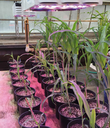Articles & Interviews
Resources | LpR Article | Technologies | UV | Horticulture
|
Feb 05, 2020
Transparent Material Considerations for UV Optics in Horticultural Lighting Applications
 Advancements in UV LED technology have begun changing the horticultural lighting landscape. Research is still ongoing to discover the extent of benefits and best practices of using UV light in horticulture. Using optics in tandem with UV LED light systems can help reach performance goals and optimize growing. Although there are several UV- transmitting materials available, not all are equivalent or able to meet the requirements for UV applications. Justine Galbraith, glass engineer, and Sharayah Follett, market development manager at Kopp Glass, Inc. discuss the performance considerations of various UV-transmitting materials and how application challenges are addressed by integrating optical elements.
Read more »
Advancements in UV LED technology have begun changing the horticultural lighting landscape. Research is still ongoing to discover the extent of benefits and best practices of using UV light in horticulture. Using optics in tandem with UV LED light systems can help reach performance goals and optimize growing. Although there are several UV- transmitting materials available, not all are equivalent or able to meet the requirements for UV applications. Justine Galbraith, glass engineer, and Sharayah Follett, market development manager at Kopp Glass, Inc. discuss the performance considerations of various UV-transmitting materials and how application challenges are addressed by integrating optical elements.
Read more »
Resources | LpR Article | Horticulture | Applications
|
Mar 28, 2019
Enriching Horticultural Lighting for Faster Growth and Better Crops
 Horticulture lighting is no new lighting application, but it gained momentum with the introduction and evolution of LED lighting, and it is meanwhile one of the fastest growing markets in lighting. Dr. Richard Blakey, Application Engineer at Würth Elektronik eiSos, explains how LED-based horticultural lighting can deliver even bigger advantages for commercial growers by introducing additional wavelengths that increase photosynthetic response - like Würth Elektronik's new members of the WL-SMDC SMD Mono-Color Ceramic LED Waterclear family that is used as a reference in the article.
Read more »
Horticulture lighting is no new lighting application, but it gained momentum with the introduction and evolution of LED lighting, and it is meanwhile one of the fastest growing markets in lighting. Dr. Richard Blakey, Application Engineer at Würth Elektronik eiSos, explains how LED-based horticultural lighting can deliver even bigger advantages for commercial growers by introducing additional wavelengths that increase photosynthetic response - like Würth Elektronik's new members of the WL-SMDC SMD Mono-Color Ceramic LED Waterclear family that is used as a reference in the article.
Read more »
Resources | LpR Article | Technologies | Horticulture | UV
|
Oct 19, 2018
UV LED Technology for Emerging Applications in Agriculture
 The Ultraviolet (UV) LED market has expanded five-fold in the past decade and is projected to grow to over $1 billion by 2025. A key trend expected to influence the market is the ability to expand into new applications, including agriculture. UV light, at proper frequency and dose, can increase the production of active substances in medicinal and traditional plants and it can also help maintain a healthy growing environment. But to fully take advantage of UV LEDs, some major re-design considerations are required. Terrance Berland, CEO of the Violet Defense Group, the parent company of Violet Gro, will explain which considerations these are; for instance, why it is crucial to incorporate the appropriate lens material.
Read more »
The Ultraviolet (UV) LED market has expanded five-fold in the past decade and is projected to grow to over $1 billion by 2025. A key trend expected to influence the market is the ability to expand into new applications, including agriculture. UV light, at proper frequency and dose, can increase the production of active substances in medicinal and traditional plants and it can also help maintain a healthy growing environment. But to fully take advantage of UV LEDs, some major re-design considerations are required. Terrance Berland, CEO of the Violet Defense Group, the parent company of Violet Gro, will explain which considerations these are; for instance, why it is crucial to incorporate the appropriate lens material.
Read more »
Resources | LpO Article | Statements | Horticulture
|
Mar 05, 2018
Paul Scheidt, Cree - Horticulture Lighting
 "When you go into horticulture application the light output level directly correlates to the yield that you see in the plants. There is no buffer, when lights dim, the yield goes down. If something degrades very quickly and is 100% for one growth cycle then goes down to 90% for the second growth cycle, you will see a reduced yield. There is no room for adjustments." Paul Scheidt
Read more »
"When you go into horticulture application the light output level directly correlates to the yield that you see in the plants. There is no buffer, when lights dim, the yield goes down. If something degrades very quickly and is 100% for one growth cycle then goes down to 90% for the second growth cycle, you will see a reduced yield. There is no room for adjustments." Paul Scheidt
Read more »
Resources | LpR Article | Interview | Trends | Horticulture
|
Sep 12, 2017
Trends in Horticulture Lighting
 Cree has been a leader in general lighting applications for over 20 years and has customers ranging from restaurant chains to global government agencies. Paul Scheidt began his career in Cree in 2005, working on the development of their lighting applications. During this time, he has seen an increase in the horticulture lighting application. LED professional spoke to Paul Scheidt about horticulture lighting and what he thinks is behind this recent trend. He also shares his views of what he thinks the future holds for both Cree and horticulture lighting applications.
Read more »
Cree has been a leader in general lighting applications for over 20 years and has customers ranging from restaurant chains to global government agencies. Paul Scheidt began his career in Cree in 2005, working on the development of their lighting applications. During this time, he has seen an increase in the horticulture lighting application. LED professional spoke to Paul Scheidt about horticulture lighting and what he thinks is behind this recent trend. He also shares his views of what he thinks the future holds for both Cree and horticulture lighting applications.
Read more »
Resources | LpR Article | Applications | Horticulture
|
Mar 13, 2017
SSL Growth Strategies and USDA Corn Breeding Objectives
 The SSL horticulture lighting industry has become one of the fastest growing branches of lighting worldwide. Much research has already been done in regards to horticultural SSL technology and continues to be rigorously explored. While most other inputs for plant growth are monitored and controlled based on plant needs, it is still common practice for light control to be rudimentary (on/off). Brandon Newkirk, Marketing Communications Manager at LumiGrow Inc., gives a short overview on the current state of dynamic LED lighting with a focus on USDA corn breeding trials and objectives.
Read more »
The SSL horticulture lighting industry has become one of the fastest growing branches of lighting worldwide. Much research has already been done in regards to horticultural SSL technology and continues to be rigorously explored. While most other inputs for plant growth are monitored and controlled based on plant needs, it is still common practice for light control to be rudimentary (on/off). Brandon Newkirk, Marketing Communications Manager at LumiGrow Inc., gives a short overview on the current state of dynamic LED lighting with a focus on USDA corn breeding trials and objectives.
Read more »
Resources | LpR Article | Applications | Animal Farming
|
Mar 13, 2017
Bio-Effective Lighting for Humans, Livestock and Plants
 Mood lighting is often misleadingly interpreted as HCL. But HCL is much more because it includes biologically effective light that is beneficial or dangerous, depending on the correct application. While the relevant parts of the radiation spectrum may differ, light is also biologically effective for plants and animals and it is used to achieve well-defined effects. Volker Neu, General Manager LED at Vossloh-Schwabe Lighting Solutions, presents examples, discusses similarities and differences between humans, animals and plants in respect to the relevant spectra, and scrutinizes possible consequences.
Read more »
Mood lighting is often misleadingly interpreted as HCL. But HCL is much more because it includes biologically effective light that is beneficial or dangerous, depending on the correct application. While the relevant parts of the radiation spectrum may differ, light is also biologically effective for plants and animals and it is used to achieve well-defined effects. Volker Neu, General Manager LED at Vossloh-Schwabe Lighting Solutions, presents examples, discusses similarities and differences between humans, animals and plants in respect to the relevant spectra, and scrutinizes possible consequences.
Read more »
